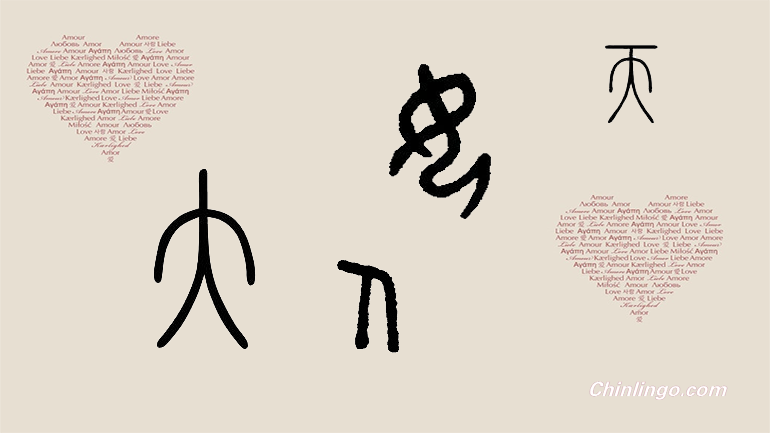
To better understand Chinese characters, we can trace them back to their source in 小篆 (Xiǎozhuàn) calligraphy. 小篆 (Xiǎozhuàn) means "small seal." It is a form of Chinese writing that dates from the Qin Dynasty (221B.C.-206B.C.).
为了更好地了解汉字,我们可以通过小篆字体追溯汉字的起源。小篆(Xiǎozhuàn)即small seal,这种字体可追溯到秦朝(公元前221年-公元前206年)。
秦始皇 (qín shǐ huáng) was the founder of the Qin Dynasty. He unified the Six Warring States and created the first Chinese empire. His minister 李斯 (lǐ sī) combined the text of the seven states to develop a common language, which is Xiǎozhuàn.
秦始皇(qín shǐ huáng)是秦王朝的创始人。他统一六国并建立了中国第一个帝国。当朝宰相李斯统一了七国文字,将小篆作为全国通用字体。
Since the Xiǎozhuàn characters often look more like pictures of the things that they represent, it can be useful and fun to see how modern characters evolved from them. (Modern scientific studies on memory and language learning show that stories and pictures are among the best ways to remember words.)
由于小篆字体的外形看起来很像其所指物体的图形,因此,了解现代汉字的进化过程,对汉语学习者来说既实用又有趣。(关于记忆以及语言学习的现代科学研究显示,故事和图片是记忆单词最有效的方式之一)。
1. nǚ 女 "woman"
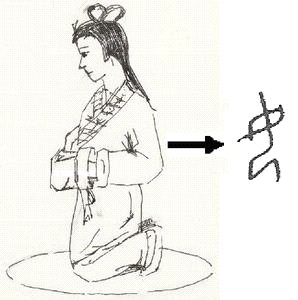
The character in the picture above is 女 (nǚ). The Xiǎozhuàn version looks like the posture of a woman on her knees. In earlier times, the social status of Chinese women was low, and they were required to kneel down to their parents, brothers, husbands, and their husband's parents. So this kneeling down posture became associated with women.
上图显示的汉字是“女 (nǚ)”字。小篆字体的“女”看起来像一位跪着的女人。在古代中国,女性的地位很低,她们需要向父母、兄弟、丈夫以及公婆跪拜。因此,跪姿则与女人联系在一起。
2. 人 (rén) "human being"
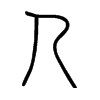
This character is 人 (rén). In ancient times, only slaves were called rén, while upper class people were called 君 (jūn), 臣 (chén) , or 大夫 (dài fū). So the rén character was a man on his knees with hands touching the ground. But now rén is 人, which is a person standing up. I think this change signifies that all human beings have dignity and value.
图片上的汉字为“人 (rén)”字。在古代,只有奴隶才被称为“人”,上流社会的人则称为“君(jūn)”,“臣(chén)”或“大夫(dài fū)”。因此“人”字看起来像一个双膝跪地并两手撑地的人。但是简体的“人”字看起来是一个站立的人。我想,这一改变意味着所有的人都有尊严和价值。
3. 大 (dà) "big"
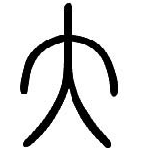
The Xiǎozhuàn version of 大 (dà) is the 人 (rén) character with his shoulders lifted up, standing up with two legs spread, which aims at showing his power. He looks like an old Western gunfighter ready to draw and shoot. But the modern character looks like a man with arms outstretched, ready to give you a big hug.
“大”的小篆字体是抬起双肩的“人”,两条腿站立分开,看起来像西方的枪手,随时准备射击。但简体“大”字看起来像一个张开双臂准备给你一个大大拥抱的人。
4. 天 (tiān) "heaven"
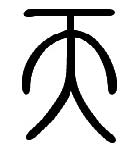
The Xiǎozhuàn version of tiān 天 (tiān) is the character 大 (dà) with an additional line on the top. It refers to the things that are above human beings. I like to think of it this way: even a big man is not bigger than heaven.
“天”的小篆字体是“大”字上面加了一横,指人上面的所有的东西。我是这样认为的:再大的人也大不过天。
Translated from: writtenchinese.com



 闽公网安备 35020302035673号
闽公网安备 35020302035673号
0 responses on "4 Chinese characters in pictographic Xiaozhuan style"